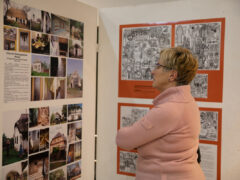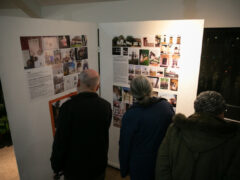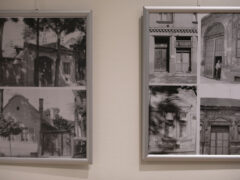In honor of the architect Emőke Pataky, a photo exhibition entitled Debrecen of the 80s opened in the Central Library of the Péter Méliusz Juhász Library in Debrecen on December 15, 2023. Deputy mayor István Puskás and architect Attila Harangi gave speeches at the event, and the event was opened by István Gábor, chief city architect.
István Puskás emphasized that with this photo exhibition, we pay tribute to the life journey of an architect who has become one of the icons of the city’s built heritage and the protection of built heritage in Debrecen. At this exhibition, interested parties can see photos of buildings in the most diverse formats, from the most diverse eras, and the most diverse locations. However, with the help of these pictures, not only a professional life journey but also a very private story unfolds. When a photographer looks at a point of the world with his camera and encloses it in a frame, it is not only about the world but also about the photographer himself, about why exactly that detail is shown, and why exactly from there. The pictures are not only about professional issues, not only about the subject but about the person himself, the way of thinking of the person who is on the other side of the camera. When we look at this exhibition, we also become part of a very personal story: with the help of these pictures, we can see Emőke Pataky’s history not only as an architect but also as a person and as a personality. István Puskás emphasized that those who view this exhibition should not only see the buildings but also look for Emőke Pataky’s personality in these photos.
István Gábor, the chief architect of the city of Debrecen, said that he considers Emőké Pataky to be his master, who, in addition to being an architect, is also a real creator in the fine arts sense, and it is worth looking at the photos she made and other works from this perspective. In-person, we can talk about a creator armed with 20th-century spirit-historical thinking, who showed that it is possible to look at our historicity, our history, and our past as some kind of ordered and well-kept thought system of beautiful secrets and fairy tales. The example of Emőke Pataky shows that not only the creative architect has a right to exist in architectural and social thinking, but also the public architect. This is a more complete life path than a multitude of realized plans. Emőke Pataky found and documented a lot of architectural values, including many folk and Debrecen architectural values, which we would not know today, and in the future, without his activity.
Architect Attila Harangi mentioned Emőke Pataky as a colleague and fellow city defender, for whom this exhibition is also a celebration in terms of presenting his fifty-year professional career. And it’s also a holiday for Debrecen, as it can be used to show the kind of recognized and respected professionals who work for the city, very enthusiastically and actively to this day. Emőke Pataky fears, protects and loves Debrecen, and with her photos, she irreplaceably documented the most endangered architectural values of Hajdú-Bihar, Szabolcs-Szatmár-Bereg and Békés counties. According to Attila Harangi, Emőke Pataky has a collection of historical and architectural documents of national importance. From this material, a collection of around 600 photos taken in the early 1980s was only recently rediscovered by the creator, and 102 of these shots are included in the exhibition. Attila Harangi expressed his hope that the monumental, architectural document collection will be processed – with the active participation of Emőke Pataky – and will be published in the form of a volume at some point in the future.
Imréné Kovács, the president of the Debrecen City Protection and Beautification Association, said in her opening remarks that Emőke Pataky is the professional vice-president of the association, and her work greatly helps their activities. Imréné Kovács expressed her hope that although Emőke Pataky could not personally attend the opening of the exhibition, there will be an opportunity to meet her in person in January and listen to her about her experiences and memories in connection with the exhibition.
(Debreceni Nap)
Photos: János Miskolczi
























